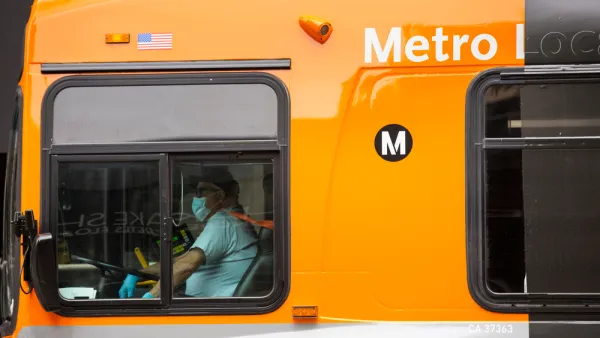Laura Bliss argues that rather than promise to reduce congestion, Los Angeles Metro should embrace its real beneficiaries: non-drivers.
Los Angeles County Metro's ambitious plans for the next 40-50 years rely on $120 billion from a proposed sales tax. Laura Bliss writes in CityLab that to win voter approval, the MTA needs to reassess how it presents the core purpose of building transit.
Transit advocacy, including Metro's own, often relies on the idea that access to transportation options reduces driving, which reduces congestion, which reduces carbon emissions.
But plenty of factors affect transit ridership rates that agencies cannot control—land-use planning and density, gas prices, free parking and other invisible driving subsidies, etc.—and research has disputed whether increased transit options really do replace driving. Bliss argues that they shouldn't have to:
"Transit doesn’t have to reduce traffic to be successful. Indeed, its central aim probably shouldn’t be serving the people who don’t actually use it. Transit’s best selling point is that it offers mobility to those who, for any number of reasons, can’t or choose not to drive. It also underpins bustling economic activity, pushes people into job centers, and improves long-term sustainability."
Embracing that angle could increase agencies' success, or even alter their project priorities—and go a long way toward clarifying the issues facing Los Angeles and other U.S. cities.
FULL STORY: To Ease Traffic, L.A. Needs Much More Than Trains

Analysis: Cybertruck Fatality Rate Far Exceeds That of Ford Pinto
The Tesla Cybertruck was recalled seven times last year.

National Parks Layoffs Will Cause Communities to Lose Billions
Thousands of essential park workers were laid off this week, just before the busy spring break season.

Retro-silient?: America’s First “Eco-burb,” The Woodlands Turns 50
A master-planned community north of Houston offers lessons on green infrastructure and resilient design, but falls short of its founder’s lofty affordability and walkability goals.

Test News Post 1
This is a summary

Analysis: Cybertruck Fatality Rate Far Exceeds That of Ford Pinto
The Tesla Cybertruck was recalled seven times last year.

Test News Headline 46
Test for the image on the front page.
Urban Design for Planners 1: Software Tools
This six-course series explores essential urban design concepts using open source software and equips planners with the tools they need to participate fully in the urban design process.
Planning for Universal Design
Learn the tools for implementing Universal Design in planning regulations.
EMC Planning Group, Inc.
Planetizen
Planetizen
Mpact (formerly Rail~Volution)
Great Falls Development Authority, Inc.
HUDs Office of Policy Development and Research
NYU Wagner Graduate School of Public Service



























